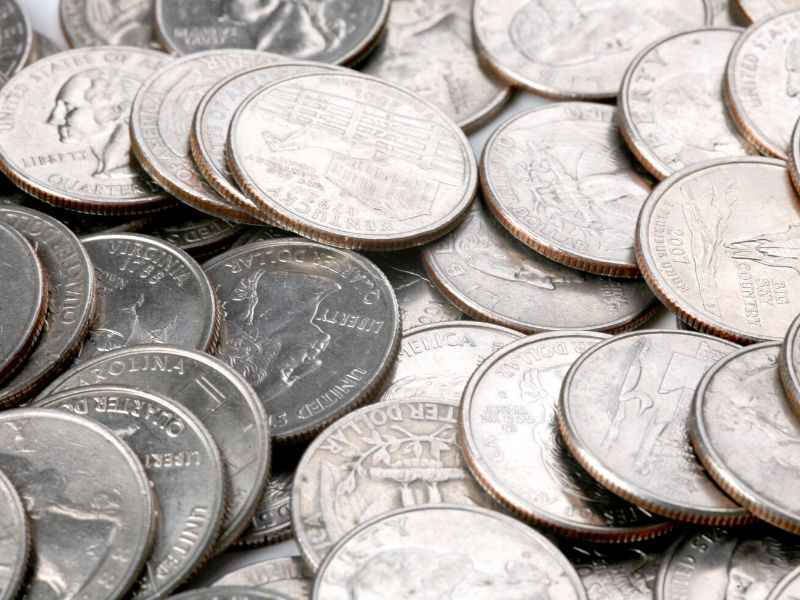The coronavirus crisis has sparked a nationwide coin shortage that has left retailers scrambling, including some laundromat owners who have found themselves short of the quarters needed to replenish changers.
The Federal Reserve recently revealed that the pandemic had “significantly disrupted” the supply chain and circulation patterns for America’s metal money. The U.S. Mint has slowed production of coins due to measures meant to protect workers amid the crisis, while coin deposits from banks also have fallen in the past few months, according to the central bank.
On June 15, with demand for coins rising as states began to reopen, the Fed started limiting how many pennies, nickels, dimes and quarters it distributed to banks as part of its efforts to “mitigate the effects of low coin inventories.” Dollar coins are not subject to the coin allocation order, so they continue to be readily available to local banks.
Regarding the coin shortage, the U.S. Mint recently shared the following statement with PlanetLaundry:
Under normal circumstances, retail transactions and coin recyclers return a significant amount of coins to circulation on a daily basis. However, precautions taken throughout the nation to slow the spread of the virus have reduced retail sales activity and significantly decreased deposits from third-party coin processors, resulting in increased orders for newly minted coins produced by the United States Mint. Third-party coin processors and retail activity account for 80 percent of coins put into circulation each year, while the Mint contributes 20 percent via newly minted coins.
Throughout the public health challenge, the Mint has continued to meet its essential mission of manufacturing coins to facilitate national commerce. At the same time, the Mint continues to take all appropriate steps to safeguard the health and safety of our workforce. The Mint acted quickly and decisively during the early phases of the crisis to implement measures to mitigate the risk of employee exposure to COVID-19. These measures included temporarily reducing the number of employees per shift in order to enhance social distancing.
The Mint continues to take all appropriate steps to safeguard the health and safety of our workforce. Prior to taking these safeguarding measures, we were on track for producing coins in accordance with forecasted demand – 1 billion coins per month for the entirety of 2020. Due to COVID-19, our production was down 10 percent in April and 20 percent in May. We were able to fulfill the Federal Reserve’s May coin order by drawing down our coin inventory. We worked mandatory Saturday overtime in May in order to increase our production, and ramped up to full production by mid-June and implemented voluntary Sunday overtime, in addition to mandatory Saturday overtime. We will produce more than 1 billion coins in June, and are planning to produce more than 1.35 billion coins per month for the remainder of the year. We have increased production while still prioritizing the health and well-being of our employees and maintaining a reduced risk of their exposure to COVID-19 in the workplace.
The Mint is partnering with the Federal Reserve’s Cash Product Office, which manages coin supply and inventory from a national perspective, to minimize potential coin shortages and ensure the health of our nation’s circulating coin supply.
As always, and especially during this challenging time, the Mint is committed to supporting our nation’s economy and commerce through the production of circulating coinage.
Simply put, coins aren’t moving. Certainly not at the velocity and volume seen during pre-COVID times. Closed bank branches, limited visits to grocery stores and retail transactions slowed to a crawl during shutdown orders have all contributed to the shortage. Even the typical spike in loose coin redemption activity seen during times of increased unemployment haven’t materialized.
Although unwilling to speculate as to how long the shortage would last, the CPO recently told the Coin Laundry Association that the answer lies with the reigniting of retail transactions and a return to consumers’ normal coin redemption activity. The CPO did indicate that it was encouraging banks to consider removing impediments to redemption activity – namely, the fees charged for handling coin and/or the requirement to roll coins for deposit.
Fed chairman Jerome Powell recently told lawmakers that the shortage is most likely a temporary situation. Coin circulation was starting to improve as states eased lockdowns meant to control the virus, he said at a hearing of the House Financial Services Committee.
“Stores have been closed,” Powell told the committee, according to an Associated Press report. “The whole system of flow had come to a stop. As the economy reopens, we’re seeing coins begin to move around again.”













